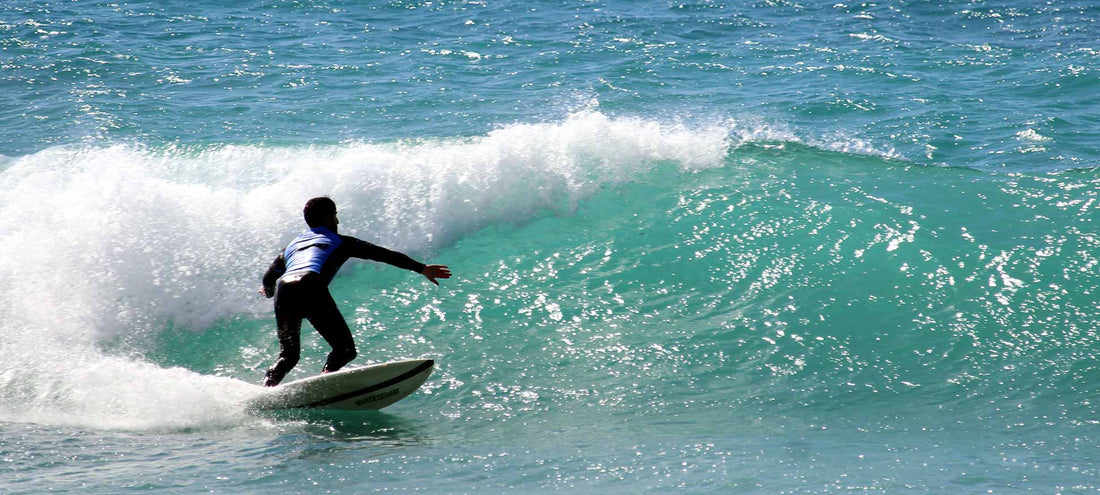
Cómo Usar Surf-Forecast para Planificar Tu Sesión de Surf en El Palmar
Share
El Palmar, Cádiz, es uno de los destinos más codiciados por surfistas de todas las edades y niveles. Con su costa salvaje y condiciones únicas durante todo el año, planificar tus sesiones de surf es esencial para aprovechar al máximo tu experiencia. En este artículo, te enseñaremos cómo utilizar Surf-Forecast, una herramienta indispensable para conocer las previsiones de olas en tiempo real.

¿Qué Es Surf-Forecast?
Surf-Forecast es una plataforma líder en información meteorológica diseñada específicamente para surfistas. Desde su creación, ha ayudado a millones de personas a entender mejor las condiciones del mar antes de entrar al agua. Proporciona datos precisos sobre:
- Altura de las Olas: Cuánto medirán las olas en diferentes puntos del día.
- Período de Ola: La cantidad de segundos entre crestas, lo que afecta la calidad de las olas.
- Dirección del Viento: Importante para determinar si será offshore (favorable) o onshore (menos ideal).
- Mareas: Horarios exactos de pleamar y bajamar, cruciales para elegir el mejor momento.
- Energía del Swell: Mide la potencia con la que llegan las olas al punto de surf, indicando qué tan fuertes serán las rompientes.
- Temperatura del Agua: Para decidir qué tipo de traje de neopreno necesitarás.
Estos datos son fundamentales para prepararte antes de entrar al agua y asegurar una sesión segura y divertida.
Por Qué Usar Surf-Forecast en El Palmar
El Palmar es conocido por sus swells consistentes durante todo el año, especialmente en invierno. Sin embargo, debido a su ubicación frente al Atlántico, las condiciones pueden variar rápidamente. Aquí es donde Surf-Forecast se convierte en tu aliado perfecto:
Olas Consistentes: Aprovecha Lo Mejor de El Palmar
El Palmar recibe swells regulares gracias a su posición estratégica frente al océano Atlántico. Durante el invierno, estas olas tienden a ser más potentes y largas, ideales tanto para principiantes como para avanzados. Al consultar Surf-Forecast, puedes identificar días con:
- Swells de 1.5-2 metros: Perfectas para practicar giros y cortes en la ola.
- Vientos Offshore Suaves: Moldean las olas, haciéndolas más fáciles de leer y surfear.
- Mareas Bajas Tempranas: Ideal para principiantes que buscan zonas menos profundas.
Además, la energía del swell te ayuda a entender qué tan fuertes serán las olas cuando lleguen a la playa. Un swell energético puede generar olas más potentes y rápidas, mientras que un swell débil producirá olas más suaves y manejables.
Temperatura Templada: Prepara Tu Equipo Adecuadamente
En El Palmar, las temperaturas del agua varían según la temporada. Durante el invierno, oscilan entre los 16-18°C, mientras que en verano suben hasta los 20-22°C. Esto significa que necesitarás un traje de neopreno adecuado dependiendo de la época:
- Invierno: Un traje de 4/3mm es ideal para mantenerte cómodo durante largas sesiones.
- Verano: Puedes optar por un traje más ligero de 2/1mm o incluso una malla corta si prefieres algo más fresco.
Al revisar la previsión de temperatura del agua en Surf-Forecast, podrás ajustar tu equipo para disfrutar al máximo sin preocupaciones.

Consejos Para Leer Correctamente la Previsión
Aunque Surf-Forecast es una herramienta poderosa, interpretar correctamente sus datos requiere algo de práctica. Aquí algunos consejos prácticos:
Combina Datos Para Tomar Decisiones Informadas
No te fijes solo en la altura de las olas; considera también otros factores clave:
- Periodo de Ola: Un periodo largo (8-12 segundos) indica olas más ordenadas y manejables, mientras que un periodo corto puede significar olas más desordenadas.
- Dirección del Viento: Los vientos offshore (que soplan desde el mar hacia la tierra) moldean las olas y las hacen más fáciles de surfear. Evita días con vientos onshore fuertes, ya que pueden arrugar la superficie del agua.
- Energía del Swell: Esta métrica te permite anticipar qué tan fuertes serán las olas cuando lleguen a la playa. Un swell energético produce olas más potentes, mientras que uno débil crea olas más suaves.
- Mareas: Las mareas afectan la forma de las olas. En El Palmar, muchas veces las mejores condiciones ocurren durante la bajamar temprana o la pleamar tardía.
Consulta Regularmente Para Mantenerte Actualizado
Las condiciones pueden cambiar rápidamente debido a factores como tormentas remotas o cambios en la dirección del viento. Por eso, es importante revisar la previsión diariamente antes de salir al agua. Además, muchos surfistas experimentados recomiendan verificar las actualizaciones justo antes de llegar a la playa.
Adapta Tu Equipo Según Las Condiciones
Dependiendo de la previsión, deberás ajustar tu equipo para garantizar comodidad y seguridad:
- Trajes de Neopreno: Escoge uno grueso en invierno y ligero en verano.
- Tablas: Usa una tabla más grande en días de olas pequeñas y una más pequeña cuando las olas sean grandes.
- Accesorios: Considera llevar protectores solares en verano y gorros de neopreno en invierno.
Tu Base Perfecta: Nuestra Surf House
Si decides visitar El Palmar y quieres estar siempre al tanto de las mejores condiciones, nuestra Surf House es el lugar ideal para alojarte. Ubicada a solo 10 minutos a pie de la playa, ofrece todo lo necesario para vivir la experiencia completa del surf:
Instalaciones Premium Para Recargar Energías
- Piscina Privada: Relájate después de intensas sesiones de surf.
- Zona de Entrenamiento: Fortalece tu cuerpo fuera del agua para mejorar tus habilidades.
- Cocina Equipada: Prepara comidas saludables y energéticas utilizando productos locales, como la famosa carne de retinto de la Carnicería Luisa.
Para más detalles sobre nuestra Surf House, visita nuestra página: Surf House en El Palmar.
Conexión Con Locales Y Otros Surfers
Nuestra comunidad está formada por surfistas apasionados que aman compartir conocimientos e historias. Obtén recomendaciones personalizadas sobre dónde encontrar las mejores olas según la previsión y descubre rincones poco conocidos de El Palmar.
Barbacoas Semanales: Comparte Experiencias
Cada sábado organizamos barbacoas en nuestra Surf House, donde disfrutas de carnes premium asadas al estilo andaluz. Es el momento perfecto para conectar con otros surfistas, intercambiar trucos y relajarte en buena compañía.
Nuestros Surfcamps: Aprende De Manos De Expertos
Si prefieres aprender con profesionales, nuestros surfcamps son perfectos para ti. Diseñados para todos los niveles, ofrecen clases personalizadas, análisis de video y experiencias inolvidables:

Surfcamps de Fin de Semana
Ideal para quienes buscan escapadas rápidas pero completas. Incluye alojamiento en nuestra Surf House, clases personalizadas, análisis de video para corregir errores y una barbacoa al aire libre los sábados.
Para más información, visita: Surfcamps de Fin de Semana.
Surfcamps Celebrity
Una oportunidad única de aprender de surfistas profesionales reconocidos internacionalmente, como Ariane Ochoa. Estas experiencias no solo mejoran tu técnica, sino que también te inspiran a llevar tu pasión al siguiente nivel.
Para más detalles, consulta: Surfcamps Celebrity.
Surfcamps en Puentes y Festivos
Programas avanzados que incluyen análisis técnico detallado y sesiones libres enfocadas en perfeccionar movimientos específicos. Perfecto para surfistas experimentados que buscan desafíos adicionales.
Más información aquí: Surfcamps en Puentes y Festivos.
Únete a Nuestra Comunidad
Con más de 180 reseñas de 5 estrellas, Carving Social Club ha creado una comunidad vibrante de amantes del surf. Únete a nosotros y vive el espíritu del océano en su forma más pura.
¿Listo para planificar tu próxima aventura? No dudes en contactarnos:
- Email: info@carvingsocialclub.com
- Teléfono: 647066320
Visita nuestra página de Surfcamps en El Palmar para más detalles.




